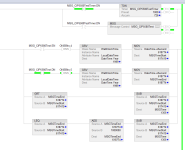I noticed something that’s mostly just a curiosity. Maybe someone here knows.
An IT system is reading a L82 with the on-board IP and 1,0 added. That’s leftover from an older processor and a ENxT module, addressing the backplane from the Ethernet module and the processor in slot 0. I wonder if it’s slightly detrimental, or just pointless. Is there any unnecessary additional data movement with the backplane and slot defined?
I tried a quick test reading a 280 byte UDT with and without 1,0 in my source MSG. The MSG was completing in 1-3 ms and I didn’t notice any difference capturing a timer.acc value to measure. As I write this, I’m thinking I could try again someday with more data, a private network, a sparse program, and the system uS.
So, I have four possibilities: The processor ignores the path to itself. That path is baked into the architecture and defining it is redundant. That actually adds a bit of overhead to the communication. Or, something else my simple mind didn’t fathom.
I would guess that adds a tiny bit of overhead. If not backplane traffic, then at least burning some amount of backplane interface power. A PLC will do whatever else you tell it to do, even if it’s not what you actually want it to do.
An IT system is reading a L82 with the on-board IP and 1,0 added. That’s leftover from an older processor and a ENxT module, addressing the backplane from the Ethernet module and the processor in slot 0. I wonder if it’s slightly detrimental, or just pointless. Is there any unnecessary additional data movement with the backplane and slot defined?
I tried a quick test reading a 280 byte UDT with and without 1,0 in my source MSG. The MSG was completing in 1-3 ms and I didn’t notice any difference capturing a timer.acc value to measure. As I write this, I’m thinking I could try again someday with more data, a private network, a sparse program, and the system uS.
So, I have four possibilities: The processor ignores the path to itself. That path is baked into the architecture and defining it is redundant. That actually adds a bit of overhead to the communication. Or, something else my simple mind didn’t fathom.
I would guess that adds a tiny bit of overhead. If not backplane traffic, then at least burning some amount of backplane interface power. A PLC will do whatever else you tell it to do, even if it’s not what you actually want it to do.



